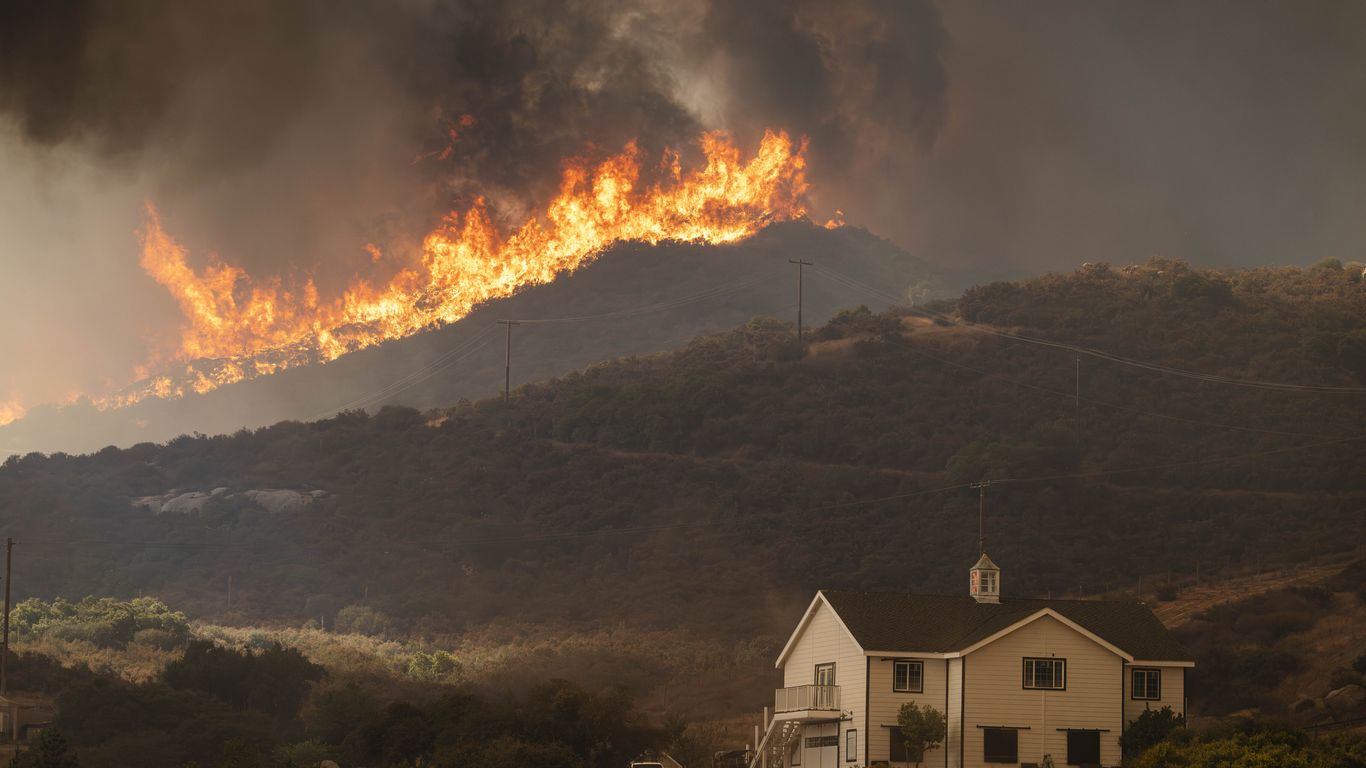Cities Under Siege: A Report On The Impacts Of Dangerous Climate Whiplash

Table of Contents
Infrastructure Breakdown Under Climate Whiplash
Climate whiplash puts immense strain on urban infrastructure, pushing existing systems beyond their design limits and causing widespread damage. The unpredictable nature of these events makes planning and mitigation exceptionally challenging.
Damage to Transportation Networks
Extreme weather events frequently disrupt transportation networks, causing significant economic losses and hindering emergency response efforts. The cascading effects of even a single event can ripple through a city for weeks or even months.
- Increased road damage from flooding and heat stress: Extreme heat causes asphalt to buckle and soften, while heavy rainfall and flooding erode road surfaces, leading to costly repairs and traffic congestion.
- Disrupted rail services due to washouts and extreme temperatures: Flash floods can wash away sections of railway tracks, while extreme heat can cause rail lines to warp and buckle, halting passenger and freight transport.
- Airport closures due to extreme weather conditions: Heavy snow, strong winds, and intense rainfall can ground flights, disrupting air travel and impacting the economy.
- Increased costs associated with infrastructure repair and maintenance: The cumulative cost of repairing and maintaining infrastructure damaged by climate whiplash places a significant burden on city budgets. This often diverts funds from other essential services.
Compromised Water and Energy Systems
Climate whiplash severely strains water resources and energy grids, leaving cities vulnerable to shortages and disruptions. The rapid shifts between extremes exacerbate existing vulnerabilities.
- Water shortages during droughts followed by overwhelmed sewage systems during flash floods: Extended periods of drought can deplete reservoirs and groundwater supplies, while subsequent intense rainfall can overwhelm sewage systems, leading to contamination and public health risks.
- Increased energy demand during heatwaves straining power grids: High temperatures increase the demand for air conditioning, which can overload power grids, leading to blackouts and power outages.
- Damage to energy infrastructure due to extreme winds and flooding: High winds can damage power lines and transmission towers, while flooding can submerge power plants and substations, disrupting electricity supply.
- Rising costs of water purification and energy production: The increased frequency and intensity of extreme weather events raise the costs of purifying water and generating electricity, impacting both consumers and businesses.
The Socioeconomic Toll of Climate Whiplash
The impacts of climate whiplash extend far beyond infrastructure damage, inflicting a heavy socioeconomic toll on cities and their inhabitants. The vulnerability of different populations is also a critical factor to consider.
Economic Disruptions and Loss of Livelihoods
Extreme weather events cause significant economic damage, impacting businesses, employment, and overall economic productivity. The recovery process is often slow and costly.
- Business closures and job losses due to damage and disruption: Businesses can be forced to close temporarily or permanently due to damage from extreme weather, leading to job losses and economic hardship.
- Increased insurance costs and decreased property values: The increased risk of damage from extreme weather events drives up insurance premiums and reduces property values, impacting homeowners and businesses alike.
- Reduced agricultural yields due to unpredictable weather patterns: Unpredictable rainfall, droughts, and extreme temperatures can severely reduce crop yields, impacting food security and livelihoods of agricultural communities.
- Tourism downturn due to damage and safety concerns: Damage to tourist attractions and safety concerns due to extreme weather can significantly reduce tourism revenue, impacting local economies.
Public Health Crisis and Displacement
Climate whiplash poses a significant threat to public health and can lead to mass displacement and migration. The vulnerable populations are disproportionately affected.
- Increased heat-related illnesses and deaths: Heatwaves can cause heatstroke, dehydration, and other heat-related illnesses, leading to increased mortality, particularly among vulnerable populations.
- Spread of waterborne diseases after floods: Flooding can contaminate water supplies, leading to outbreaks of waterborne diseases such as cholera and typhoid.
- Increased respiratory problems due to air pollution exacerbated by wildfires: Wildfires, often exacerbated by drought conditions, can release large amounts of harmful air pollutants, leading to respiratory problems and other health issues.
- Mass displacement due to extreme weather events and sea-level rise: Extreme weather events such as floods and hurricanes can force people to evacuate their homes, leading to mass displacement and migration.
Mitigation and Adaptation Strategies for Climate Whiplash
Addressing the challenge of climate whiplash requires a multifaceted approach that combines mitigation and adaptation strategies. Proactive measures are essential to reduce vulnerability and build resilience.
Investing in Resilient Infrastructure
Cities need to invest in climate-resilient infrastructure to withstand the impacts of extreme weather events. This requires a long-term vision and substantial investment.
- Building flood defenses and improving drainage systems: Investing in flood defenses such as levees, seawalls, and improved drainage systems can help protect cities from flooding.
- Developing heat-resistant building materials and urban design: Using heat-resistant building materials and designing urban spaces to maximize shade and ventilation can help mitigate the impacts of heatwaves.
- Upgrading energy grids to withstand extreme weather events: Investing in more resilient energy grids can help ensure a reliable electricity supply during extreme weather events.
- Investing in early warning systems for extreme weather: Developing and implementing early warning systems can provide communities with crucial time to prepare for and respond to extreme weather events.
Community Preparedness and Resilience
Community resilience is crucial in mitigating the effects of climate whiplash. Empowering communities to prepare and respond effectively is vital.
- Educating communities about the risks of climate whiplash: Raising public awareness about the risks of climate whiplash can help individuals and communities prepare for and respond to extreme weather events.
- Developing community-based emergency response plans: Developing and implementing community-based emergency response plans can help ensure effective response to extreme weather events.
- Investing in community-based adaptation projects: Supporting community-based adaptation projects can help communities develop their own solutions to the challenges of climate whiplash.
- Fostering community-level disaster preparedness training and drills: Providing communities with disaster preparedness training and conducting regular drills can help build community resilience.
Conclusion
Climate whiplash presents a profound and multifaceted challenge to cities worldwide. The devastating impacts on infrastructure, economies, and public health demand immediate and decisive action. Addressing this crisis requires a multifaceted approach that includes substantial investment in resilient infrastructure, robust community preparedness, and ambitious efforts to mitigate climate change. By prioritizing these strategies, we can lessen the devastating effects of climate whiplash and build more sustainable and resilient urban environments. We must act now to safeguard our cities from the escalating threat of climate whiplash and build a more secure future. Learn more about how to mitigate the impacts of climate whiplash and build resilient communities.

Featured Posts
-
 O Kosmos Toy Goyes Anterson Zontaneyei Se Ekthesi Sto Londino
May 28, 2025
O Kosmos Toy Goyes Anterson Zontaneyei Se Ekthesi Sto Londino
May 28, 2025 -
 Tatis Jr S Return To The Padres Leadoff Position
May 28, 2025
Tatis Jr S Return To The Padres Leadoff Position
May 28, 2025 -
 Gubernur Koster Tetapkan Strategi Penyaluran Bkk Untuk 6 Kabupaten
May 28, 2025
Gubernur Koster Tetapkan Strategi Penyaluran Bkk Untuk 6 Kabupaten
May 28, 2025 -
 Did Saleng Earn More At Moroka Swallows Than Orlando Pirates
May 28, 2025
Did Saleng Earn More At Moroka Swallows Than Orlando Pirates
May 28, 2025 -
 Lordes Surprise Appearance At Lorde Themed Night Fans React
May 28, 2025
Lordes Surprise Appearance At Lorde Themed Night Fans React
May 28, 2025
